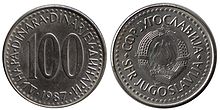Yugoslav dinar
The Yugoslav dinar (abbreviation: Din ) was the official currency of the Kingdom of Yugoslavia , the Socialist Federal Republic of Yugoslavia and the Federal Republic of Yugoslavia until 2003, where it changed form and value several times. It was divided into 100 para .
history
Like the Serbian dinar, which was valid until 1920, the Yugoslav currency was named after the Roman silver coin denarius . On January 1, 1966, the dinar was reformed; two zeros were simply deleted, i.e. H. 100 “old dinars” became 1 “new dinar”. Curiously, up until the breakup of Yugoslavia, older people calculated in "old dinars", i.e. added the zeros again. The dinar was a very stable currency for a real socialist country in the 1960s and 1970s . It had an exchange rate of 7: 1 with the German mark, but fell sharply in the 1980s , especially after Tito's death . The main reasons for the high inflation were the increasingly negative balance of payments and foreign debt of the Yugoslav economy and government, which put increasing pressure on the exchange rate (and thus the import prices). The inflationary tendency was additionally strengthened by the indexing of the incomes in the industry in the form of a wage-price spiral, which in turn led to further devaluations of the currency and thus initiated a circular process. This could not be stopped until the dissolution of the Yugoslav federation by the government, as well as the Yugoslav national bank , the Narodna Banka Jugoslavije .
After the collapse of Yugoslavia, the dinar was only retained in the rump state , consisting of the republics of Serbia and Montenegro . However, in 1999 Montenegro introduced the Deutsche Mark as a parallel currency and one year later even made it the only valid national currency. The re-galloping inflation was tried several times with the help of reforms.
- on January 1, 1990 : 10,000 new dinars = 1 convertible dinar
- on July 1, 1992 : 10 (convertible) dinars of the Socialist Federal Republic of Yugoslavia = 1 dinar of the Federal Republic of Yugoslavia
- on October 1, 1993 : 1,000,000 (old) dinars = 1 (new) dinars
- on January 1, 1994 : 1,000,000,000 (old) dinars = 1 (new) dinars
- on July 22, 1994 : 12,000,000 (old) dinars = 1 new dinar (also officially called Novi Dinar )
This means that a new dinar from 1994 corresponds to 1,200,000,000,000,000,000,000,000,000 (or 1.2 · 10 27 or 1.2 quadrillion) old dinars from before 1990.
After a short transition period, the former republics of Slovenia and Croatia introduced the Slovenian tolar and the Croatian kuna (previously the Croatian dinar ) as the successor to the dinar. In 2003 it was replaced by the Serbian dinar in Serbia and the euro in Montenegro .
description
It was characteristic of the dinar banknotes of socialist Yugoslavia that, as with other currencies, they usually did not adorn celebrities on the banknotes, but anonymous people such as workers, peasants or objects such as ships and monuments.
The notes issued from 1965 to 1970 show:
- 5 dinars: farmer's wife
- 10 dinars: workers based on a photo by Arif Heralić
- 50 dinars: Monument in Serbia
- 100 dinars: "Peace Rider"
- 500 dinars: Nikola Tesla monument
Notes or fantasy drafts issued later are also included in this scheme:
- 1 dinar: woman in costume
- 3 dinars: soldiers
- 20 dinars: ship
- 1000 dinars: farmer's wife

This tradition was to be broken with the introduction of the 5,000-dinar note and 10,000-dinar note; the former adorned the portrait of Josip Broz Tito in 1986 . The latter was to show the Serbs Vuk Stefanović Karadžić in 1986 . Since this portrait was not issued due to the rivalries between the states, from 1987 the 20,000 dinar note was used again to access unknown or anonymous persons. It was only when Narodna Banka Jugoslavije was actually only responsible for Serbia that well-known people were shown.

On all dinar coins the monetary value was minted on the front, the national coat of arms of the SFR Yugoslavia , consisting of ears of corn, flames, star and the date of establishment of the state, November 29, 1943, on the back, in memory of the anti-fascist council for the liberation of the people of Yugoslavia .
See also
- Serbian dinar
- Croatian dinar
- Croatian kuna
- Slovenian tolar
- Bosnian dinar
- Bosnian convertible mark
- Republika Srpska Dinar
- Macedonian denarius
- Euro
Web links
- Historical banknotes of Yugoslavia (1968–1991)
- Historical banknotes of Yugoslavia (1992–1993)
- Historical banknotes of Yugoslavia (1994–1999)
Individual evidence
- ↑ The triumph of the Mark. In: Spiegel Online. November 13, 2000, accessed November 20, 2011 .


